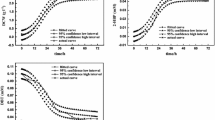Abstract
Using cell-free extracts of a desulfurizing mesophile, Rhodococcus erythropolis KA2-5-1 (the Dsz system) and Escherichia coli JM109, which possesses the desulfurizing genes of a thermophile Paenibacillus sp. A11-2 (the Tds system), the reactivity of desulfurizing enzymes toward 4,6-dialkyl dibenzothiophenes (4,6-dialkyl DBTs) and 7-alkyl benzothiophenes (7-alkyl BTs) was investigated. Both systems desulfurized all the 4,6-dialkyl DBTs, except 4,6-dibutyl DBT. Although some alkylated BTs were degraded by the Dsz system, no desulfurized compounds were detected. The reactivity of the Tds system toward alkylated BTs was higher than that of DBT. In contrast to the Dsz system, the Tds system yielded desulfurized compounds from all of the alkylated BTs examined.
Similar content being viewed by others
References
Constanti M, Giralt J, Bordons A (1994) Desulfurization of dibenzothiophene by bacteria. World J. Microbiol. Biotechnol. 10: 510-516.
Denome SA, Oldfield C, Nash LJ, Young KD (1994) Characterization of the desulfurization genes from Rhodococcus sp. strain IGTS8. J. Bacteriol. 176: 6707-6716.
Foght JM, Fedorak PM, Gray MR, Westlake DWS (1990) Microbial desulfurization of petroleum. In: Ehrlich HL, Brieley CL, ed. Microbial Mineral Recovery. New York: McGraw-Hill Book Co., pp. 379-407.
Gray KA, Pogrebinsky OS, Mrachko GT, Xi L, Monticello DJ, Squires CH (1996) Molecular mechanisms of biocatalytic desulfurization of fossil fuels. Nat. Biotechnol. 14: 1705-1709.
Hirasawa K, Ishii Y, Kobayashi M, Koizumi K, Maruhashi K (2001) Improvement of desulfurization activity in Rhodococcus erythropolis KA2-5-1 by genetic engineering. Biosci. Biotechnol. Biochem. 65: 239-246.
Ishii Y, Konishi J, Okada H, Hirasawa K, Onaka T, Suzuki M(2001) Operon structure and functional analysis of the genes encoding thermophilic enzymes of Paenibacillus sp. A11-2. Biochem. Biophys. Res. Commun. 270: 81-88.
Ishii Y, Konishi J, Suzuki M, Maruhashi K (2000) Cloning and expression of the gene encoding the thermophilic NAD(P)H-FMN oxidoreductase coupling with the desulfurization enzymes from Paenibacillus sp. A11-2. J. Biosci. Bioeng. 90: 591-599.
Izumi Y, Ohshiro T, Ogino H, Hine Y, Shimao M (1994) Selective desulfurization of dibenzothiophene by Rhodococcus erythropolis D-1. Appl. Environ. Microbiol. 60: 109-123.
Kilbane JJ (1989) Desulfurization of coal: the microbial solution. Trends Biotechnol. 7: 97-101.
Kobayashi M, Horiuchi K, Yoshikawa O, Hirasawa K, Ishii Y, Fujino K, Sugiyama H, Maruhashi K (2001) Kinetic analysis of microbial desulfurization of model and light gas oils containing multiple alkyl dibenzothiophenes. Biosci. Biotechnol. Biochem. 65: 298-304.
Kobayashi M, Onaka T, Ishii Y, Konishi J, TakakiM, Okada H, Ohta Y, Koizumi K, Suzuki M (2000) Desulfurization of alkylated forms of both dibenzothiophene and benzothiophene by a single bacterial strain. FEMS Microbiol. Lett. 187: 151-154.
Konishi J, Ishii Y, Onaka T, Okumera K, Suzuki M (1997) Thermophilic carbon-sulfur-bond-targeted biodesulfurization. Appl. Environ. Microbiol. 63: 3164-3169.
Konishi J, Ishii Y, Onaka T, Ohta Y, Suzuki M, Maruhashi K (2000a) Purification and characterization of dibenzothiophene sulfone monooxygenase and FMN-dependent NADH oxidoreductase from the thermophilic bacterium Paenibacillus sp. strain A11-2. J. Biosci. Bioeng. 90: 607-613.
Konishi J, Onaka T, Ishii Y, Suzuki M (2000b) Demonstration of the carbon-sulfur bond targeted desulfurization of benzothiophene by thermophilic Paenibacillus sp. strain A11-2 capable of desulfurizing dibenzothiophene. FEMS Microbiol. Lett. 187: 151-154.
Ohshiro T, Kojima T, Torii K, Kawasoe H, Izumi Y (1999) Purifi-cation and characterization of dibenzothiophene (DBT) sulfone monooxygenase, an enzyme involved in DBT desulfurization, from Rhodococcus erythropolis D-1. J. Biosci. Bioeng. 88: 610-616.
Ohshiro T, Suzuki K, Izumi Y (1997) Dibenzothiophene degrading enzyme responsible for the first step of DBT desulfurization by Rhodococcus erythropolis D-1: purification and characterization. J. Ferment. Bioeng. 83: 233-237.
Piddinton CS, Kovacevich BR, Rambosek J (1995) Sequence and molecular characterization of a DNA region encoding the dibenzothiophene desulfurization operon of Rhodococcus sp. strain IGTS8. Appl. Environ. Microbiol. 61: 468-475.
Shennan JL (1996) Microbial attack on sulfur-containing hydrocarbons. J. Chem. Tech. Biotechnol. 67: 109-123.
Wang P, Kraviec S (1994) Desulfurization of dibenzothiophene to 2-hydroxybiphenyl by some newly isolated bacterial strains. Arch. Microbiol. 161: 266-271.
Author information
Authors and Affiliations
Rights and permissions
About this article
Cite this article
Konishi, J., Okada, H., Hirasawa, K. et al. Comparison of the substrate specificity of the two bacterial desulfurization systems. Biotechnology Letters 24, 1863–1867 (2002). https://doi.org/10.1023/A:1020957516297
Issue Date:
DOI: https://doi.org/10.1023/A:1020957516297




